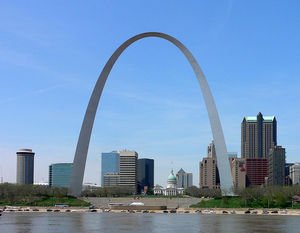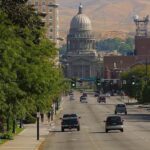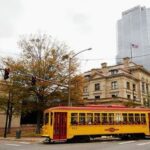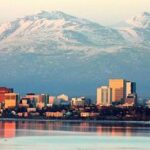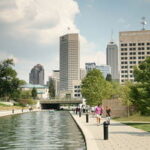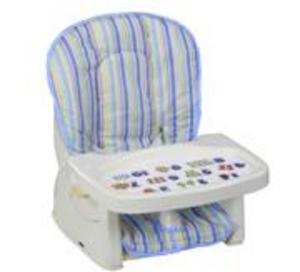This article, the twenty-fifth in a 50-state series, lists the largest cities in Missouri by population size and provides demographic details for each city: total population, population by age group, racial composition of the population, land area, and population density. For purposes of this article, cities are incorporated municipalities and census-designated places (CDPs).
After reading “Largest Cities in Missouri (2011),” return to this link to read “Best Places to Live in Missouri (2011).”
Similar articles for the remaining 49 states can be found at these links: Alabama, Alaska, Arizona, Arkansas, California, Colorado, Connecticut, Delaware, Florida, Georgia, Hawaii, Idaho, Illinois, Indiana, Iowa, Kansas, Kentucky, Louisiana, Maine, Maryland, Massachusetts, Michigan, Minnesota, Mississippi, Montana, Nebraska, Nevada, New Hampshire, New Jersey, New Mexico, New York, North Carolina, North Dakota, Ohio, Oklahoma, Oregon, Pennsylvania, Rhode Island, South Carolina, South Dakota, Tennessee, Texas, Utah, Vermont, Virginia, Washington, West Virginia, Wisconsin, and Wyoming.
1. Largest Cities in Missouri (2011): Kansas City, MO
Located in western Missouri, Kansas City is the largest city in the state with an estimated population of 459,787.
Grouped by age, 24.2% of the population is under 18, 9.8% is 18 to 24, 29.8% is 25 to 44, 25.2% is 45 to 64, and 11.0% is 65 or older. The median age of the population is 34.6.
The racial composition of the city is 59.2% White, 29.9% Black or African American, 0.5% Native American, 2.5% Asian, 0.2% Pacific Islander, 4.5% from other races, and 3.2% from two or more races. The population is 10.0% Hispanic or Latino of any race.
The land area of the city is 313.5 square miles. The city’s population density is 1,467 people per square mile.
2. Largest Cities in Missouri (2011): St. Louis, MO
Situated in eastern Missouri, St. Louis is the second largest city in the state with an estimated population of 319,294.
Classified by age, 21.2% of the population is under 18, 12.3% is 18 to 24, 30.6% is 25 to 44, 24.9% is 45 to 64, and 11.0% is 65 or older. The median age of the population is 33.9.
The racial complexion of the city is 43.9% White, 49.2% Black or African American, 0.3% Native American, 2.9% Asian, 1.3% from other races, and 2.4% from two or more races. The population is 3.5% Hispanic or Latino of any race.
The land area of the city is 61.9 square miles. The city’s population density is 5,158 people per square mile.
3. Largest Cities in Missouri (2011): Springfield, MO
Located in southwestern Missouri, Springfield is the third largest city in the state with an estimated population of 159,498.
A comparatively large part of the population is college-aged: the city is home to Missouri State University. Categorized by age, 18.3% of the population is under 18, 18.5% is 18 to 24, 26.0% is 25 to 44, 22.7% is 45 to 64, and 14.5% is 65 or older. The median age of the population is 33.2.
The racial profile of the city is 88.7% White, 4.1% Black or African American, 0.8% Native American, 1.9% Asian, 0.2% Pacific Islander, 1.2% from other races, and 3.2% from two or more races. The population is 3.7% Hispanic or Latino of any race.
The land area of the city is 73.2 square miles. The city’s population density is 2,179 people per square mile.
4. Largest Cities in Missouri (2011): Independence, MO
Situated in western Missouri, Independence is the fourth largest city in the state with an estimated population of 116,830.
Sorted by age, 23.0% of the population is under 18, 8.6% is 18 to 24, 24.9% is 25 to 44, 27.4% is 45 to 64, and 16.1% is 65 or older. The median age of the population is 39.4.
The racial makeup of the city is 85.7% White, 5.6% Black or African American, 0.6% Native American, 1.0% Asian, 0.7% Pacific Islander, 3.2% from other races, and 3.2% from two or more races. The population is 7.7% Hispanic or Latino of any race.
The land area of the city is 78.3 square miles. The city’s population density is 1,492 people per square mile.
5. Largest Cities in Missouri (2011): Columbia, MO
Located in central Missouri, Columbia is the fifth largest city in the state with an estimated population of 108,500.
An unusually large part of the population is college-aged: the city is home to the University of Missouri. Arranged by age, 18.8% of the population is under 18, 27.4% is 18 to 24, 26.7% is 25 to 44, 18.6% is 45 to 64, and 8.5% is 65 or older. The median age of the population is 26.8.
The racial mix of the city is 79.0% White, 11.3% Black or African American, 0.3% Native American, 5.2% Asian, Pacific Islander 0.1%, 1.1% from other races, and 3.1% from two or more races. The population is 3.4% Hispanic or Latino of any race.
The land area of the city is 60.1 square miles. The city’s population density is 1,805 people per square mile.
6. Largest Cities in Missouri (2011): Lee’s Summit, MO
Located in western Missouri, Lee’s Summit is the sixth largest city in the state with an estimated population of 91,364.
Grouped by age, 28.0% of the population is under 18, 7.0% is 18 to 24, 27.0% is 25 to 44, 26.6% is 45 to 64, and 11.4% is 65 or older. The median age of the population is 37.2.
The racial composition of the city is 86.1% White, 8.4% Black or African American, 0.3% Native American, 1.7% Asian, 0.1% Pacific Islander, 1.1% from other races, and 2.4% from two or more races. The population is 3.9% Hispanic or Latino of any race.
The land area of the city is 59.5 square miles. The city’s population density is 1,536 people per square mile.
7. Largest Cities in Missouri (2011): O’Fallon, MO
Situated in eastern Missouri, O’Fallon is the seventh largest city in the state with an estimated population of 79,329.
Classified by age, 30.0% of the population is under 18, 7.2% is 18 to 24, 30.8% is 25 to 44, 23.1% is 45 to 64, and 8.9% is 65 or older. The median age of the population is 34.3.
The racial complexion of the city is 89.9% White, 4.0% Black or African American, 0.2% Native American, 3.2% Asian, 0.1% Pacific Islander, 0.8% from other races, and 1.8% from two or more races. The population is 2.7% Hispanic or Latino of any race.
The land area of the city is 22.5 square miles. The city’s population density is 3,526 people per square mile.
8. Largest Cities in Missouri (2011): St. Joseph, MO
Located in northwestern Missouri, St. Joseph is the eighth largest city in the state with an estimated population of 76,780.
Categorized by age, 23.6% of the population is under 18, 11.5% is 18 to 24, 26.1% is 25 to 44, 24.9% is 45 to 64, and 13.9% is 65 or older. The median age of the population is 35.6.
The racial profile of the city is 87.8% White, 6.0% Black or African American, 0.5% Native American, 0.9% Asian, 0.2% Pacific Islander, 2.0% from other races, and 2.7% from two or more races. The population is 5.7% Hispanic or Latino of any race.
The land area of the city is 43.5 square miles. The city’s population density is 1,765 people per square mile.
9. Largest Cities in Missouri (2011): St. Charles, MO
Situated in eastern Missouri, St. Charles is the ninth largest city in the state with an estimated population of 65,794.
Sorted by age, 19.7% of the population is under 18, 14.0% is 18 to 24, 25.9% is 25 to 44, 26.6% is 45 to 64, and 13.8% is 65 or older. The median age of the population is 36.6.
The racial makeup of the city is 87.5% White, 5.9% Black or African American, 0.3% Native American, 2.5% Asian, 0.1% Pacific Islander, 1.8% from other races, and 1.9% from two or more races. The population is 4.2% Hispanic or Latino of any race.
The land area of the city is 20.4 square miles. The city’s population density is 3,225 people per square mile.
10. (tie) Largest Cities in Missouri (2011): Blue Springs, MO
Located in western Missouri, Blue Springs is tied as the tenth largest city in the state with an estimated population of 52,575.
Arranged by age, 27.9% of the population is under 18, 8.5% is 18 to 24, 27.8% is 25 to 44, 26.4% is 45 to 64, and 9.4% is 65 or older. The median age of the population is 34.7.
The racial mix of the city is 87.6% White, 6.2% Black or African American, 0.5% Native American, 1.2% Asian, Pacific Islander 0.2%, 1.3% from other races, and 3.1% from two or more races. The population is 5.0% Hispanic or Latino of any race.
The land area of the city is 18.2 square miles. The city’s population density is 2,889 people per square mile.
Largest Cities in Missouri (2011): St. Peters, MO
Situated in eastern Missouri, St. Peters is tied as the tenth largest city in the state with an estimated population of 52,575.
Grouped by age, 23.2% of the population is under 18, 8.4% is 18 to 24, 26.9% is 25 to 44, 30.0% is 45 to 64, and 11.5% is 65 or older. The median age of the population is 38.8.
The racial composition of the city is 91.7% White, 3.7% Black or African American, 0.2% Native American, 1.8% Asian, 0.1% Pacific Islander, 0.8% from other races, and 1.8% from two or more races. The population is 2.5% Hispanic or Latino of any race.
The land area of the city is 21.2 square miles. The city’s population density is 2,480 people per square mile.
11. Largest Cities in Missouri (2011): Florissant, MO
Located in eastern Missouri, Florrisant is the eleventh largest city in the state with an estimated population of 52,158.
Grouped by age, 23.9% of the population is under 18, 8.6% is 18 to 24, 26.2% is 25 to 44, 25.8% is 45 to 64, and 15.5% is 65 or older. The median age of the population is 38.0.
The racial composition of the city is 69.3% White, 26.8% Black or African American, 0.2% Native American, 0.8% Asian, 0.6% from other races, and 2.3% from two or more races. The population is 2.0% Hispanic or Latino of any race.
The land area of the city is 11.4 square miles. The city’s population density is 4,575 people per square mile.
12. Largest Cities in Missouri (2011): Joplin, MO
Situated in southwestern Missouri, Joplin is the twelfth largest city in the state with an estimated population of 50,150.
Grouped by age, 22.6% of the population is under 18, 12.6% is 18 to 24, 26.2% is 25 to 44, 23.8% is 45 to 64, and 14.8% is 65 or older. The median age of the population is 35.0.
The racial composition of the city is 87.6% White, 3.3% Black or African American, 1.8% Native American, 1.6% Asian, 0.3% Pacific Islander, 1.7% from other races, and 3.6% from two or more races. The population is 4.5% Hispanic or Latino of any race.
The land area of the city is 31.4 square miles. The city’s population density is 1,597 people per square mile.
13. Largest Cities in Missouri (2011): Chesterfield, MO
Located in eastern Missouri, Chesterfield is the thirteenth largest city in the state with an estimated population of 47,484.
Grouped by age, 22.3% of the population is under 18, 5.6% is 18 to 24, 19.5% is 25 to 44, 32.5% is 45 to 64, and 20.1% is 65 or older. The median age of the population is 46.6.
The racial composition of the city is 86.5% White, 2.6% Black or African American, 0.2% Native American, 8.6% Asian, 0.7% from other races, and 1.4% from two or more races. The population is 2.8% Hispanic or Latino of any race.
The land area of the city is 31.5 square miles. The city’s population density is 1,507 people per square mile.
14. Largest Cities in Missouri (2011): Jefferson City, MO
Situated in central Missouri, Jefferson City is the fourteenth largest city in the state with an estimated population of 43,079.
Grouped by age, 20.9% of the population is under 18, 10.3% is 18 to 24, 28.6% is 25 to 44, 26.8% is 45 to 64, and 13.4% is 65 or older. The median age of the population is 37.5.
The racial composition of the city is 78.0% White, 16.9% Black or African American, 0.3% Native American, 1.8% Asian, 0.1% Pacific Islander, 0.8% from other races, and 2.2% from two or more races. The population is 2.6% Hispanic or Latino of any race.
The land area of the city is 27.3 square miles. The city’s population density is 1,578 people per square mile.
15. Largest Cities in Missouri (2011): Cape Girardeau, MO
Located in southeastern Missouri, Cape Girardeau is the fifteenth largest city in the state with an estimated population of 37,941.
A large percentage of the population is college-aged: the city is home to Southeast Missouri State University. Grouped by age, 19.3% of the population is under 18, 20.3% is 18 to 24, 23.5% is 25 to 44, 22.2% is 45 to 64, and 14.7% is 65 or older. The median age of the population is 32.1.
The racial composition of the city is 81.1% White, 12.8% Black or African American, 0.2% Native American, 1.9% Asian, 1.5% from other races, and 2.4% from two or more races. The population is 2.8% Hispanic or Latino of any race.
The land area of the city is 24.3 square miles. The city’s population density is 1,561 people per square mile.
16. Largest Cities in Missouri (2011): Oakville, MO
Situated in eastern Missouri, Oakville is the sixteenth largest city in the state with an estimated population of 36,143.
Grouped by age, 22.8% of the population is under 18, 7.9% is 18 to 24, 21.1% is 25 to 44, 33.9% is 45 to 64, and 14.3% is 65 or older. The median age of the population is 43.7.
The racial composition of the city is 96.0% White, 0.8% Black or African American, 0.1% Native American, 1.8% Asian, 0.3% from other races, and 1.0% from two or more races. The population is 1.4% Hispanic or Latino of any race.
The land area of the city is 16.1 square miles. The city’s population density is 2,245 people per square mile.
17. Largest Cities in Missouri (2011): Wildwood, MO
Located in eastern Missouri, Wildwood is the seventeenth largest city in the state with an estimated population of 35,517.
Grouped by age, 30.3% of the population is under 18, 5.6% is 18 to 24, 20.3% is 25 to 44, 34.8% is 45 to 64, and 9.0% is 65 or older. The median age of the population is 41.5.
The racial composition of the city is 92.2% White, 1.7% Black or African American, 0.2% Native American, 4.0% Asian, 0.4% from other races, and 1.5% from two or more races. The population is 2.3% Hispanic or Latino of any race.
The land area of the city is 66.0 square miles. The city’s population density is 538 people per square mile.
18. Largest Cities in Missouri (2011): University City, MO
Situated in eastern Missouri, University City is the eighteenth largest city in the state with an estimated population of 35,271.
Grouped by age, 19.5% of the population is under 18, 11.1% is 18 to 24, 28.5% is 25 to 44, 24.7% is 45 to 64, and 16.2% is 65 or older. The median age of the population is 37.4.
The racial composition of the city is 50.8% White, 41.1% Black or African American, 0.3% Native American, 4.3% Asian, 0.9% from other races, and 2.7% from two or more races. The population is 2.8% Hispanic or Latino of any race.
The land area of the city is 5.9 square miles. The city’s population density is 5,995 people per square mile.
19. Largest Cities in Missouri (2011): Ballwin, MO
Located in eastern Missouri, Ballwin is the nineteenth largest city in the state with an estimated population of 30,404.
Grouped by age, 24.9% of the population is under 18, 6.7% is 18 to 24, 23.7% is 25 to 44, 29.5% is 45 to 64, and 15.2% is 65 or older. The median age of the population is 41.2.
The racial composition of the city is 89.3% White, 2.5% Black or African American, 0.2% Native American, 5.6% Asian, 0.6% from other races, and 1.7% from two or more races. The population is 2.4% Hispanic or Latino of any race.
The land area of the city is 9.0 square miles. The city’s population density is 3,378 people per square mile.
20. Largest Cities in Missouri (2011): Raytown, MO
Situated in western Missouri, Raytown is the twentieth largest city in the state with an estimated population of 29,526.
Grouped by age, 23.1% of the population is under 18, 7.9% is 18 to 24, 24.9% is 25 to 44, 27.8% is 45 to 64, and 16.3% is 65 or older. The median age of the population is 40.3.
The racial composition of the city is 67.7% White, 25.1% Black or African American, 0.5% Native American, 1.0% Asian, 0.2% Pacific Islander, 1.9% from other races, and 3.5% from two or more races. The population is 5.1% Hispanic or Latino of any race.
The land area of the city is 9.9 square miles. The city’s population density is 2,982 people per square mile.
More Articles from J.C. Grant
“Average ACT Scores by State (2010)”
“Average SAT Scores by State (2010)”
“Largest U.S. Cities: Population Size (2011)”
“Most_Dangerous_Cities in America – Murder Rates”
State Education Rankings: Graduation Rates for High School, College, and Grad/Professional School
“State Education Rankings: SAT Scores”
Source(s):
“American Fact Finder,” U.S. Census Bureau
Population, Housing Units, Area, and Density: 2000,” U.S. Census Bureau
